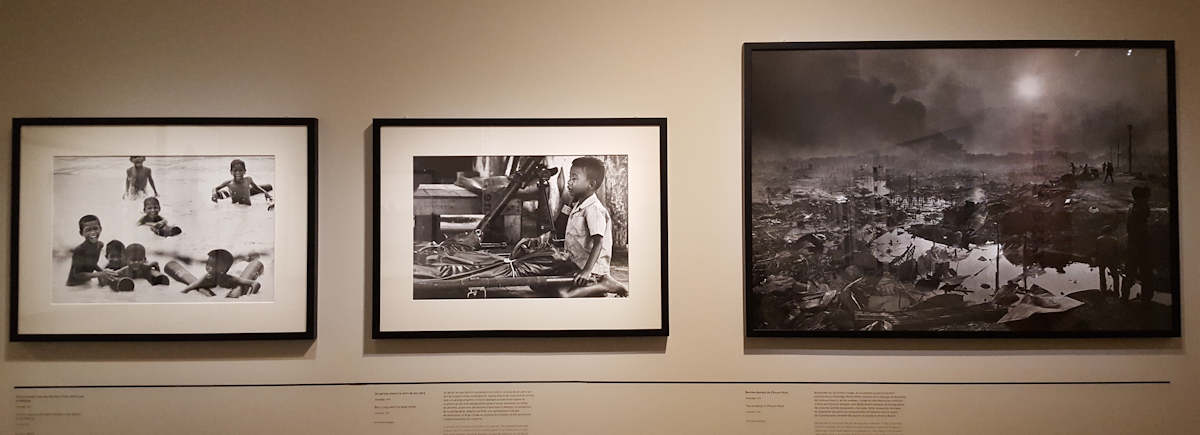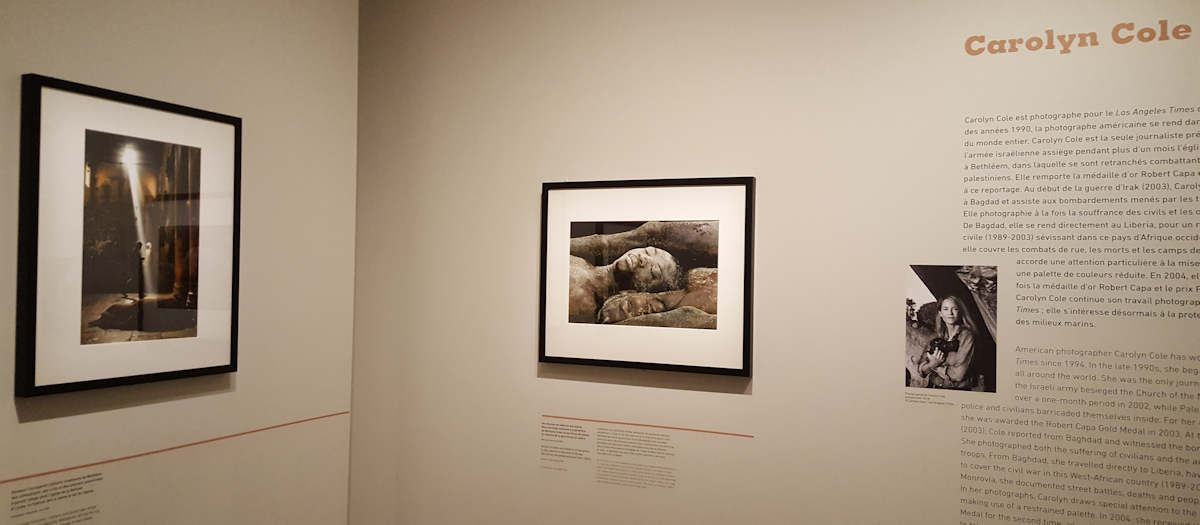
Three photographs by Christine Spengler in Women War Photographers.
It’s fair to say that an exhibition about war photography is always timely—inevitably, somewhere, there’s an armed conflict going on. But Women War Photographers has now opened while Russia tries to execute its cruel, murderous design on Ukraine, and its showing at the Museum of the Liberation of Paris makes it all the more poignant.
The timeliness that the show’s organizers had in mind in mounting this exhibition likely had less do to with any ongoing war than with the current vogue for “lest we forget the contribution of women” shows. Case in point, just a week earlier Pioneers: Women Artists in Paris of the Roaring Twenties opened at Paris’s Luxembourg Museum.
But it’s impossible to consider the powerful images of the eight photojournalists presented in this exhibition without thinking about the war now killing, maiming and displacing Europeans in numbers not seen since the Second World War. That the photographers are women is nearly irrelevant.
Co-organized with Dusseldorf’s Kunstpalast, the exhibition presents the work of photojournalists who covered armed conflicts from 1936 to 2011, from the Spanish Civil War to the War in Afghanistan by way of WWII, Vietnam, Northern Ireland and conflicts in the Middle East, Latin America, Chad and elsewhere. Of the eight war photographers—three French, three American, one German, one Dutch—two were mortally wounded while on assignment and a third came to suffer from depression, possibly linked to PTSD.
Their documenting of armed conflicts includes a wide range of approaches and angles, from closely cropped intimacy to direct confrontation to devastated landscapes and stolen lives. Heightened by the brief descriptions that accompany each image, each photographer exposes brutal and (at the time) newsworthy narratives.
(Meanwhile, the Army Museum at the Invalides has put together a studious exhibition entitled Photography at War, showing April 2 to July 24.)

Several images in Women War Photographers show survivors’ or combatants’ attempts at solace, of normalcy and of moving on among the ruins, but there are no saviors. The photographers often reveal the disequilibrium between the armed and the unarmed or lesser armed. They document various facets of threat, menace, aftershock, pain. They reveal the death and destruction that’s left after a moment or extended period of combat. The vast majority of images are in black-and-white. Several photos present views of life pursued but none presents a vision of hope.
In a photograph by the American Carolyn Cole, several men appear to be peacefully, seductively asleep side by side though the image’s context tells us they have been killed.
A rare scene of joy is found in an image by French photograph Christine Spengler showing Cambodian boys playing in the waves with spent rocket shells. But that joy is immediately dismissed, even mocked, when, in the high-contrast photograph beside it, we see one of those boys in tears, kneeling by a body bag that, the caption explains, contains his father. Beside that second photograph is a hazy image of Phenom Penh, bombed and in ruin.
Along with biographical panels for the eight photographers that can make us want to learn more about each of them, the texts and captions accompanying each image provide valuable insights and information for understanding the moment in history or the given conflict. Some are also accompanied by information about the editorial choices made in publishing the photograph or series of photographs, adding to the interest of the exhibition.

The biographies, captions and other explanations—all are in French and in English—provide enough information for a multilayered reading of the singular and collective images of the eight photographers: as individual narratives, as reflections of the broader armed conflict, as works of photojournalism, and as the work of women.
Of those possible readings, the latter turns out to be the least significant. This is not the war photography version of Mary Cassatt among the Impressionists. Clearly, each of these photojournalists was/is courageous, determined and professional. Thankfully, little attempt is made to distinguish theirs from the work of their male counterparts or to describe the particular struggles that women photographers may have in carrying out their assignments in a war zone.
In fact, the overriding subject here turns out to be less the photographers themselves—however worthy they are of awards, further study and movie biopics—and more the significance of the photographic narratives they presented of the various conflicts when published in the Western press. That in turn invites us to examine our own understanding of and reaction to images on our screens.
We are to assume that the photographs presented here were published for their newsworthiness—to tell a certain “truth” of the moment. However, their very attempt at presenting newsworthy “truth” reminds us that images can be used as propaganda and manipulation by news corporations, social networks and their users, politicians and government or governmental lapdogs. Even in their brevity the texts serve as a reminder of the importance of critical thinking when it comes to our own viewing, discussion and sharing of images and videos.
The intensity of the narratives told in Women War Photographers makes this gathering of images and texts horribly mesmerizing and insightful and this exhibition among the most notable in Paris this season.

The eight photographers
Gerda Taro, pseudonym of Gerta Poharylle, born in Germany in 1910, covered the Spanish Civil War in 1936 and 1937 along her partner Robert Capa (pseudonym of Endre Ernő Friedmann). She was fatally wounded while covering combat action in Spain in 1937, shortly before he 27th birthday, and is buried in Paris’s Père Lachaise Cemetery.
The American Lee Miller (1907-1977) was the rare female photojournalists to be accredited by the U.S. Army as a war correspondent in Europe during the Second World War, beginning a month after the D-Day Landing in Normandy and through to the liberation of Nazi concentration camps and the end of the war. Previously she had worked as a fashion model, photo portraitist and fashion photographer. Though she continued to work in the 1950s and eventually switched gears to become a gourmet chef, she was increasingly debilitated by depression or PTSD, likely caused by her war experience. She is the subject of the documentary Lee Miller, a Life on the Front Line.
Born in Paris, Catherine Leroy (1944- 2006) earned her chops as a war photographer at the age of 22 as a U.S. accredited photographer during the Vietnam War despite having no prior professional experience as a photographer. In 1976, for her coverage of the Lebanese Civil War, she was the first woman to receive the Robert Capa Gold Medal honoring the “Best photographic reporting from abroad requiring exceptional courage and enterprise.”
Françoise Demulder (1947-2008) was another Paris-born photographer who was largely self-taught. She launched her career by reporting on Vietnam War. For her coverage of the Karantina massacre in 1976, when Christian militias killed hundreds of Palestinian refugees during the Lebanese Civil War, she became, the following year, the first female photographer to receive the World Press Photo Award. She went on to cover numerous conflicts around the world.
The early career of Anja Niedringhaus was devoted to covering the Yugoslav Wars in the 1990s. She went on to cover war zones in Iraq, Afghanistan, Gaza and Libya, and in 2005 receive a Pulitzer Prize for her work in Iraq. She was killed during combat in Afghanistan while covering the country’s presidential elections on April 4, 2014. In 2015, the International Women’s Media Foundation created The Anja Niedringhaus Courage in Photojournalism Award in her honor.
Frenchwoman Christine Spengler, born in 1945, simultaneously took up photography and photojournalism when she found herself in the midst of a war zone while traveling through Chad. Before long, in 1972, she was covering The Troubles in Northern Ireland, followed by assignment in Vietnam, Cambodia, Western Sahara, the Middle East, Afghanistan and Irak.

American Susan Meiselas, born in 1948, has covered wars and humanitarian crises in Central and South America. She was awarded the Robert Capa Gold Medal in 1979 for her documenting of the Nicaraguan Revolution. Information about her career and current projects can be found on her own website.
Carolyn Cole, born in 1961, another American, has worked for the Los Angeles Times since 1994. Her coverage of war zones began several years later. She was awarded the Robert Capa Gold Medal in 2003 for her coverage of the siege by the Israeli Army at the Church of the Nativity in Bethlehem. The following year she received a second Robert Capa Gold Medal for her coverage of conflicts in Iraq and Liberia. She also received a Pulitzer in 2004 “for her cohesive, behind-the-scenes look at the effects of civil war in Liberia, with special attention to innocent citizens caught in the conflict.”
Practical information
Women War Photographers / Femmes Photographes de Guerre, March 8 to December 31, 2022, at the Museum of the Liberation of Paris*, 4 avenue du Colonel Rol-Tanguy, Place Denfert Rochereau, in the 14th arrondissement, across the street from the entrance to the Catacombes. Open Tuesday-Sunday, 10AM-6PM.
Entrance the permanent exhibition is free, however there is a fee to enter this temporary exhibition.
Purchase of a timed tickets for the exhibition is recommended: 8€ + 1€ online reservation fee. Free entrance for those under 18, with no additional online reservation fee for a timed ticket.
*I refer to the museum where this exhibition takes place as the Museum of the Liberation of Paris however it’s full name also includes the General Leclerc Museum and the Jean Moulin Museum. All three are related to the Second World War. Though each is called a “museum” they are separate sections of the same structure. Read this France Revisited article about the museums.
© 2022, Gary Lee Kraut


Thanks for this wonderful review, Gary. Clearly a must-see.